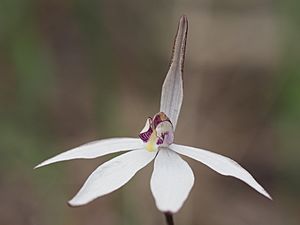Sugar orchid facts for kids
Quick facts for kids Sugar orchid |
|
|---|---|
 |
|
| Caladenia saccharata in Beverley | |
| Scientific classification | |
| Genus: |
Caladenia
|
| Species: |
saccharata
|
| Synonyms | |
|
|
The Caladenia saccharata, often called the sugar orchid, is a type of flowering plant. It belongs to the amazing Orchid family. This special orchid only grows in the south-west part of Western Australia.
It has just one leaf and one beautiful flower. The flower has three white parts called sepals and two similar petals.
Contents
What Does the Sugar Orchid Look Like?
The sugar orchid is a plant that grows from the ground. It lives for many years and loses its leaves in some seasons. It has a round, white, fleshy part underground called a tuber. This tuber helps the plant store food. Each year, a new tuber grows from a short, root-like stem.
Its Leaf
The plant has one long, narrow leaf. It grows from the bottom of the plant. The leaf is pale yellowish-green on both sides. It is also a bit hairy. It measures about 4 to 8 centimeters (1.6 to 3.1 inches) long. The leaf is usually 2 to 3 millimeters (0.08 to 0.12 inches) wide. You might see irregular reddish-purple spots near its base.
Its Flower
Each sugar orchid grows one special flower. It sits on a thin, hairy stem. This stem is usually 5 to 15 centimeters (2 to 6 inches) tall. The flower itself is about 2 to 3 centimeters (0.8 to 1.2 inches) long and wide. It has a strong smell, like musky cinnamon. But it does not produce any sweet nectar.
The flower has three white sepals and two petals. The two side sepals are similar in size and shape to the two petals. They are about 10 to 15 millimeters (0.4 to 0.6 inches) long. They curve slightly forward. The top sepal is a bit narrower. Its sides curve inwards, looking "pinched." The sepals and petals have tiny, dark, sticky hairs on their back.
Like many orchids, one petal is very different. This special petal is called the labellum. It is smooth and divided into three parts. The side parts stand up. They are cream-colored with clear purple lines and spots. The middle part has smooth yellow bumps called calli in two rows.
The parts of the flower that help it reproduce are joined together. This part is called the column. It is narrow and curves forward. It also has two see-through wings.
When Does it Flower?
Sugar orchids usually flower from August to September. After flowering, a dry fruit forms. This fruit is a capsule. It opens up when ripe to release many tiny seeds.
How the Sugar Orchid Got Its Name
The sugar orchid, Caladenia saccharata, was first officially described in 1871. A scientist named Heinrich Gustav Reichenbach wrote about it. The description was published in a book called Beitrage zur Systematischen Pflanzenkunde.
The name saccharata comes from a Latin word. Saccharum means "sugar." This is why it's called the sugar orchid!
In 2004, two other scientists, Stephen Hopper and Andrew Brown, suggested putting this orchid in a new group called Ericksonella. They named Ericksonella to honor Rica Erickson. She was a famous botanist, writer, and artist. However, not everyone agrees with this change, so it is still mostly known as Caladenia saccharata.
Where the Sugar Orchid Lives
The sugar orchid grows in many different types of soil. You can find it in sand and clay. It lives in shrubland near salt lakes. It also grows in woodlands and thickets of sheoak trees. These places are often around granite rocks.
You can find this orchid across a wide area in Western Australia. It grows from near Paynes Find all the way to Israelite Bay. It also grows inland as far as Coolgardie and Norseman.
Is the Sugar Orchid Safe?
The Western Australian Government's Department of Parks and Wildlife has looked at the sugar orchid. They have classified it as "not threatened." This means it is not currently in danger of disappearing.

